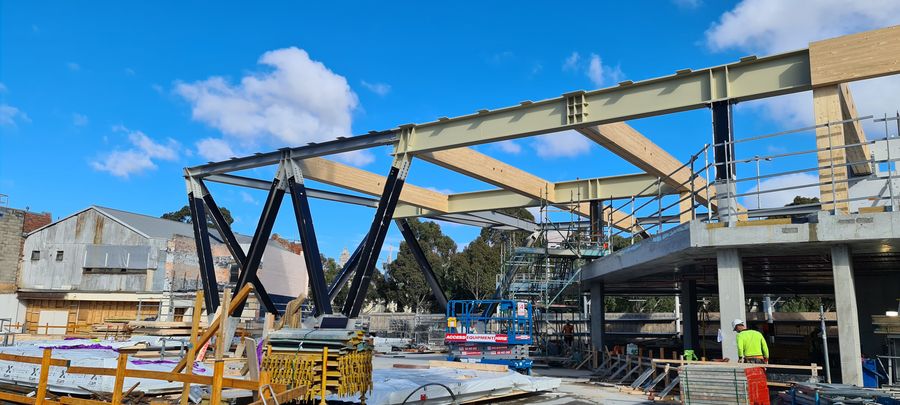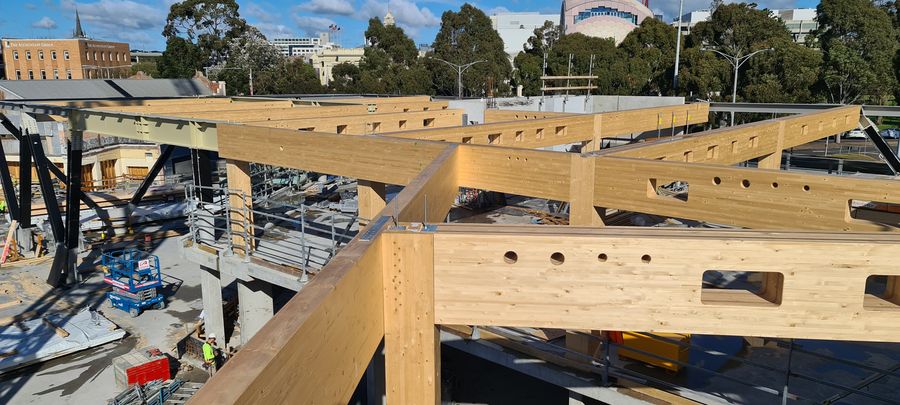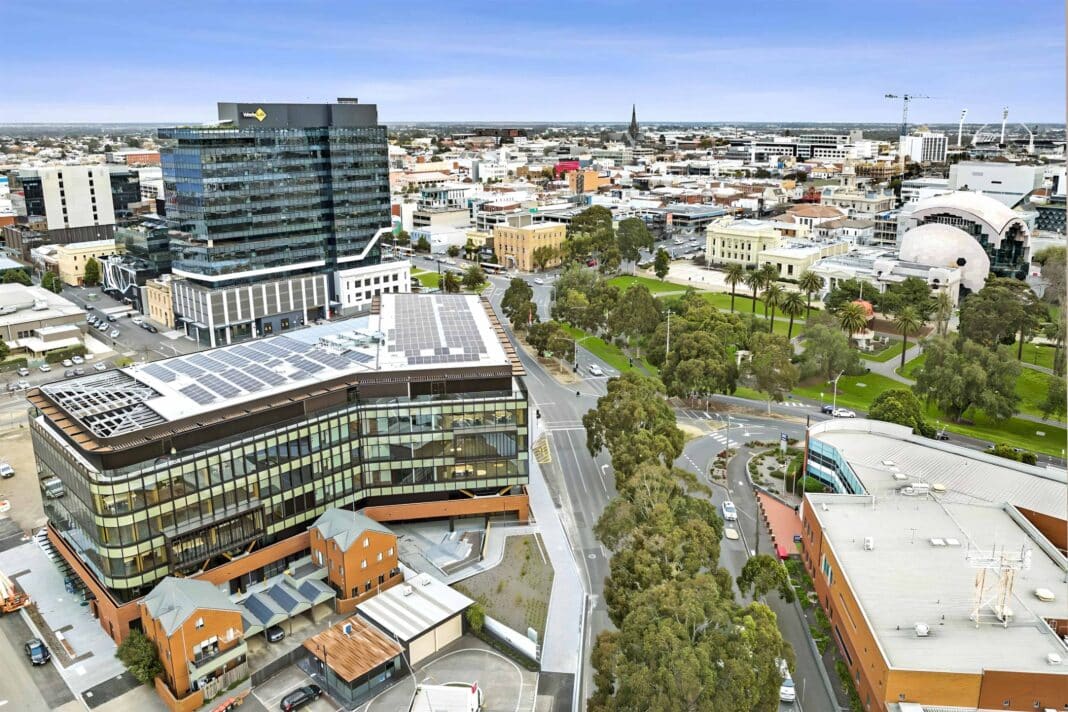The Wurriki Nyal Civic Precinct, a mixed-use development that now accommodates the City of Geelong chambers, has been awarded a 6-star Green Star rating by the Green Building Council of Australia.
The $220m building opened last year and is arguably Australia’s most sustainable government building, with the Council proudly reporting the rating acknowledged “world leadership” in the built environment.
Significantly, the use of cross-laminated timber (or CLT), glue-laminated columns and beams was “a significant contributor in achieving the 6-star accreditation,” with the rating “looking at the overall carbon reduction for the entire lifecycle of the building, from materials to construction right through to demolition.”
Designed by Cox Architecture, the building features a hybrid structural system utilising concrete, steel and CLT in equal measure, “creating a light-filled, healthy, contemporary workplace.”
Initially unveiled as a concept in 2019, the decision to use cross-laminated timber rather than conventional steel was a bold move by the Geelong City Council, which in 2017 became the first Australian city crowned “UNESCO City of Design.”
According to Cox Architecture, this award drove the Council to embrace CLT in what was, at the time, an exemplary project for the client and practice to ensure the building was both innovative and sustainable.
At the time, Chris Tucker, Director at Cox Architecture, said, “There is a lot of potential in mass-engineered timber and timber-hybrid structures, enabling urban planners and architects to develop innovative and sustainable architecture.”
“As a renewable material, CLT has significant advantages over traditional construction in terms of environmental impacts, off-site manufacturing, speed, weight, and expressed structure.”
The building was made from a mass timber post and beam system, with Besix Watpax, the head contractor for the project, appointing Xlam Australia to supply and install the timber for the project.
Xlam Australia was involved in the design development and detailed connection design of mass timber components. It provided 1,800m³ of CLT, used in the floors and soffits, but also imported 1,020 m³ of glulam spruce from Hess Timbers, which formed structural post and beams for the project.


Hess Timber, which also provided timber to the International House and its sister building, Daramu House in Sydney, tailor-made glulam composite beams to allow penetrations into the glulam without restrictions on load-bearing capacity or clear height and the need for additional reinforcements.
These composite beams consisted of three individual glulam components block bonded with two laminated veneer lumber (LVL) panels made of BauBuche. In addition, it also supplied 10 m3 of curved glulam, used in the building’s curved external facade.
The Cox Architecture design team, which included Christina Prodromou and Patrick Ness, said, “The materials were selected to be robust and low maintenance in the higher parts of the buildings, and more natural, tactile, and visually interesting at the lower levels near the public interface, reinforcing the design’s human scale.”
Reference was also made to Geelong’s maritime and wool store history using tactile masonry and timber finishes, contrasted against modern clean-line facades.
Wurriki Nyal Civic Precinct is the latest project in what the Green Building Council of Australia’s CEO Davina Rooney said is a resurgence in timber buildings achieving 5 and 6-star Green Star ratings.
Between 2011 and 2018, just five timber buildings were registered for Green Star, including 25 King Street, which doubled with six more in 2019 and 2020 and again with 16 in 2021, 2022 and 2023.
“Of all the timber buildings buildings registered with the Green Building Council over history, we’ve done more than 50% in the last three years alone,” Ms Rooney said last month.
The pivot towards timber is part of a shifting focus from operational carbon to reducing emissions connected to the construction process.
“Developers know the pathway to net-zero in operations,” Ms Rooney said, which includes taking gas out of buildings, securing renewable electricity, and better using ventilation.
The Geelong City Council is no different, with the Wurriki Nyal Civic Precinct expected to emit 571,607 kilograms of equivalent carbon emissions per annum compared with a building using standard concrete construction methods, which is expected to emit 1,120,995 kilograms of equivalent carbon emissions per annum.
“The difference is equivalent to powering 70 homes and taking 122 cars off the road per year and avoiding the burning of 278,942 kilos of coal annually,” the Council said.
The building also features a 140kW solar panel-covered roof, which the Council said will reduce the city’s annual energy cost for decades.






